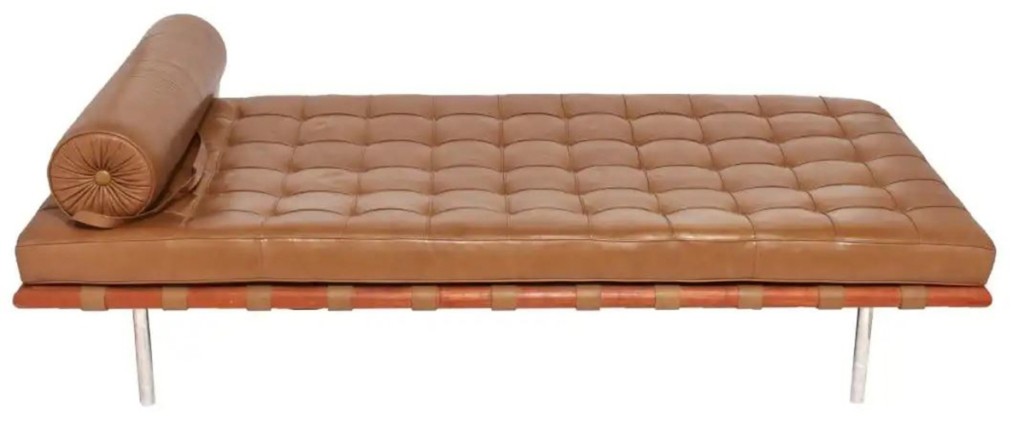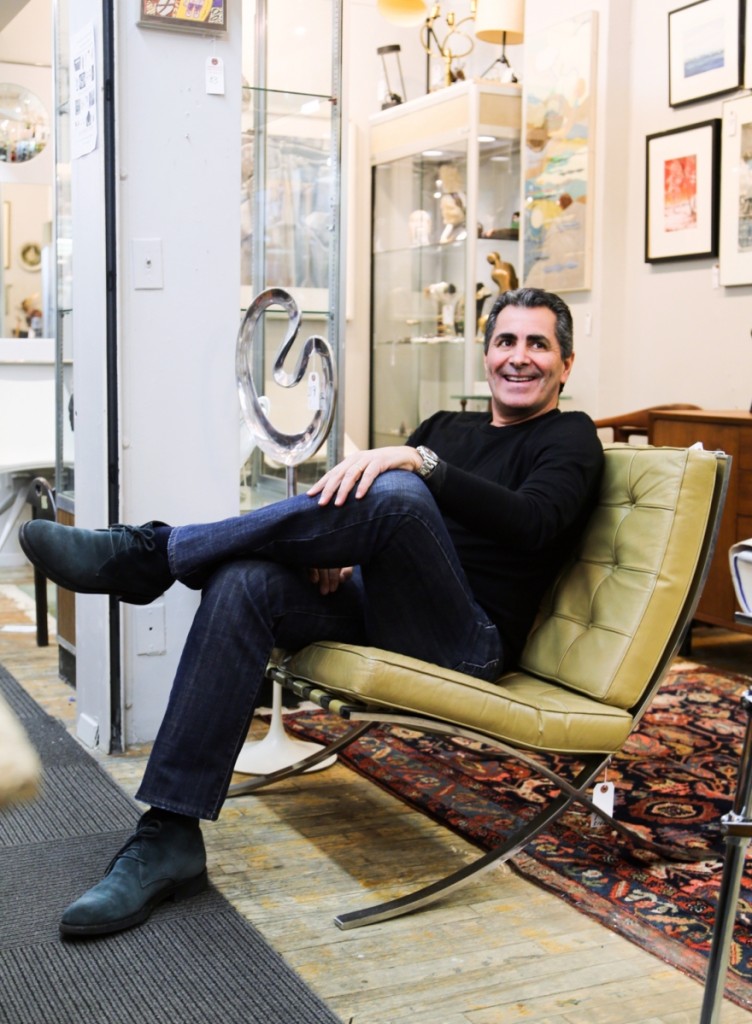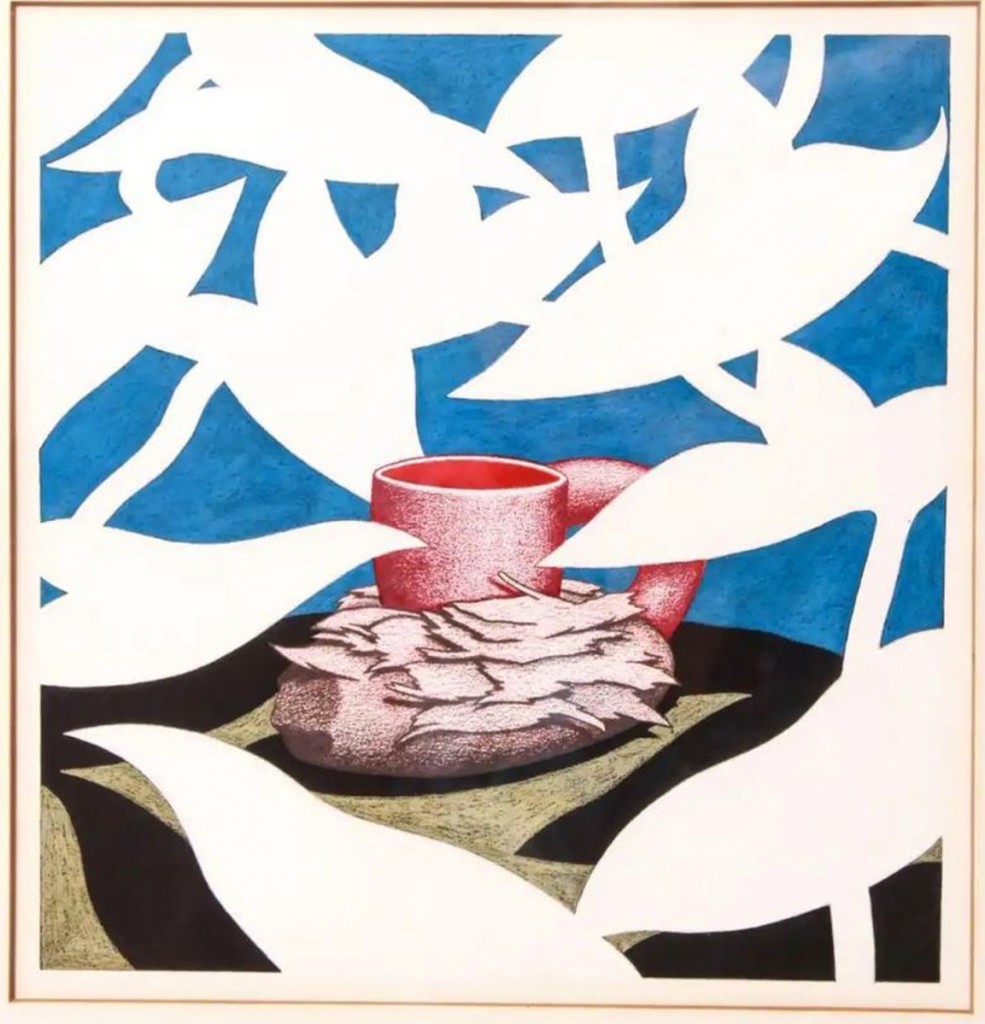
One of Knoll’s most iconic productions was Ludwig Mies van der Rohe’s Barcelona daybed. This was Peter Knoll’s most valuable piece of furniture that reached the sale, fetching $7,200.
Review and Onsite Photos by Greg Smith
NEW YORK CITY – The estate of Peter Knoll was served up at Auctions at Showplace between two sales, February 3 and 17.
Peter Knoll was the son of world-renowned furniture manufacturer Hans Knoll, who began the Hans Knoll Furniture Company in 1941. Peter was one of two children produced by Hans Knoll’s first 1939 marriage to Barbara Southwick, then a student at the National Academy of Design. Knoll and Southwick would divorce shortly after and Knoll would marry his second wife, architect and designer Florence Schust, in 1946. Together they would create the design empire known as Knoll Associates. Schust passed away January 25, 2019.
Peter Knoll’s passing preceded Schust by just over a year when he died at age 75 in January, 2018, inside his Upper East Side townhouse. His death, reported in articles from the New York Daily News to the Seattle Times, sparked controversy and a state investigation at the time. The articles allege that he had been without heat in his home since 2014 when he had a boiler replaced, but ConEdison would not turn on his gas due to a safety issue. That issue never was resolved. Succumbing to hypothermia, Knoll’s death would open up calls for revamped regulations on utilities when it comes to seniors and their well-being.
Through the objects and art that he left behind – fine watches, furniture, paintings, prints and more – Peter Knoll surrounded himself with luxury. He did, of course, fill the rooms of his home with many pieces of furniture manufactured by his family’s business. Most were early editions, others were prototypes and some pieces had experimental elements to them that never made it to the final design. He was, indeed, a follower of modernism.
Buyers of all kinds found the material desirable. “It was incredible,” said Amos Balaish, president of Showplace Antique + Design Center. “We had 150 people here for part one with many collectors and galleries showing up. We create an event with champagne and food, people like being here.”
When asked on what was memorable from the Knoll collection, Ballaish noted the selection of art and the furniture from iconic designers, but he also said, “He had a great watch collection.” The top lot of Knoll’s collection proved itself a timepiece, but not a wristwatch. It was instead an early Twentieth Century Zenith Le Locle giltwood and glass wall-mounted eight-day regulator half-round clock, which sold for $18,000. Moving on to wearable timepieces, at $7,800 was an 18K white gold Rolex Oyster Perpetual Datejust with 18K white gold Rolex bracelet. An early Movado Chronograph men’s watch with Arabic numerals went over the $1,800 high estimate to bring $6,600. A doctor’s watch, the face featured a pulsometer scale. Not far behind that at $5,100 was an 18K rose gold Prim-A-Lux Hi-Matic.

Amos Balaish, president of Showplace Antique + Design Center, with Peter Knoll’s Barcelona chair designed by Ludwig Mies van der Rohe. It sold for $1,200.
Knoll’s collection of furniture included many of the designers that his family’s business produced over the past 80 years: Florence Knoll, Ludwig Mies van der Rohe, Eero Saarinen, Richard Schultz, Warren Platner, Angelo Mangiarotti, Massimo Vignelli and others.
Among designs from Florence Knoll, cabinets reigned supreme. An Italian marble top six-drawer credenza led the designer’s offerings at $3,300. Behind at $1,920 was a travertine top five-drawer low dresser that had a small hole drilled through the top to accommodate a drawer locking mechanism. That aspect would not make it into mass-produced models. A variation of the same chest with four drawers, a white marble top, and exhibiting the same locking mechanism, would sell at $1,440. An all-teak example of Knoll’s iconic floating wall-mounted sideboard with leather pulls would bring $1,920.
Ludwig Mies van der Rohe’s iconic Barcelona daybed in a medium-tone brown leather was a notable result, selling for $7,200. The designer would further be represented by three Barcelona chairs, which all sold individually and by condition at $1,800, $1,200 and $420, the latter for a frame without cushions. A pair of brown leather BRNO chairs caught $780, while a single brought $240. Van der Rohe’s Barcelona low table would take $510.
Designs by Eero Saarinen and Warren Platner were found desirable. Platner’s wire-frame circular low coffee table with glass top brought $1,800, above its high estimate. Saarinen’s offerings were summed up by a Tulip side table with dark gray marble top that sold for $600 and a “Twilight” blue boucle wool Womb chair that took $720. The age on the Womb chair was demonstrated by its crunch. The original foam had oxidized and would need to be redone, but it was certifiably an early original and had its Knoll Associates upholstery label to the bottom.
Peter Knoll also collected furniture from other titans of design, including Hans Wegner, Arne Vodder and, surprisingly, Ron Arad. All three of Wegner’s lots were chairs, including two round armchairs with cane seats, $3,600; a pair of teak armchairs with cane seats and backs for Carl Hansen, $2,400; and a 1960s vintage Peacock chair for Johannes Hansen, $2,280. The lone Vodder design came in the form of four teak dining chairs with leather seats, manufactured by Sibast, which sold for $1,020. A chrome tubular steel frame chair from Ron Arad was Knoll’s only piece of contemporary design that made it to sale. The seat and back were made of plastic-coated springs and the chair was one of 70 produced by Arad’s One Off studio in 1981. It sold for $2,040.
Among his effects were two chairs of the same model that Peter Knoll designed and had made himself. The chairs were folding lounges and featured black lacquered wood slats, open arms and cushions. Both had their original “Peter Knoll Products” branded box and both sold at $1,680 each.

The top art lot from the Knoll estate was Ken Price’s (American, 1935–2012) 1970 gouache on paper “Forest Wart Cup” that took $13,200. It had a gallery label from Brooke Alexander Gallery in New York City and measured 10½ by 9½ inches.
Knoll’s art selection was led with Ken Price’s (American, 1935-2012) 1970 gouache on paper “Forest Wart Cup.” The image measured 10½ by 9½ inches and sold for $13,200. The two prints that followed, a work from each Josef Albers and Ellsworth Kelly, could have been mistaken as being from the same series. Albers’ red variegated color serigraph screen print, “IS – JP,” took $10,800. Ellsworth Kelly’s (American, 1923-2015) “Black/Green” color lithograph on Arjomari paper, circa 1970-72, took $9,600. Behind at $5,640 was Robert Motherwell’s untitled color etching and aquatint in red, black and gray.
In silver, worthwhile mentions included a sterling silver bowl on coiled snake feet by Marcus & Co., which sold at $3,600 and weighed 51.49 ozt. A set of 18 Tiffany & Co. sterling silver Olympian pattern ice cream dessert forks with gold washed bowls brought $3,000.
Three Louis Vuitton lots found new homes, including a cognac leather trunk at $5,100 and two leather suitcases, both embossed with Knoll’s name, that sold at $2,280 and $1,680.
The auction house confirmed that many of the lots sold to private buyers, though some of the items held sentimental value for those who had known Peter Knoll. “Many of his friends and family who knew him were purchasing a few of his things back,” said Ballaish.
The firm’s March 3 sale offers in part the collection of architect Hugh Hardy, whose work can be seen in many projects throughout New York City.
For additional information, www.nyshowplace.com/live-auctions or 212-633-6063.





















